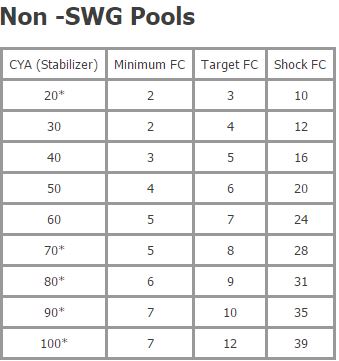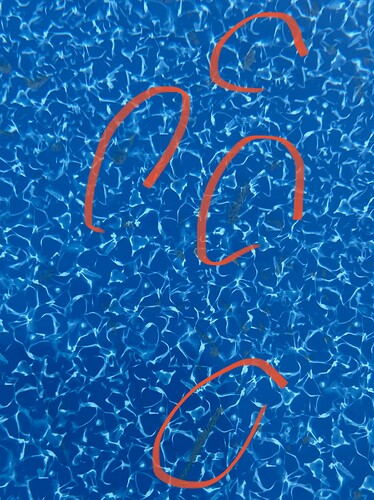Ok. I am beyond frustrated. New pool owner. My wife is supposed to be handling the chemicals. But it looks like I need to take over. 18×33 (~14000 gal)above ground pool installed 7/5. It probably wasn’t started correctly. This is supposed to be a saltwater pool. Since day 1, we never really had much chlorine showing. The salt generator (Saltron Retro) doesn’t seem to be generating chlorine or working correctly. The indicator on it says salt is low. She added 10 bags originally and then another 3 to the indicator to not read low. Now pool store says salt is high. We are temporarily giving up on the salt gen and trying to get some chlorine (using liquid chlorine)in the pool before it turns green or something. Have noticed a slight bit of sliminess on the walls. CYA was low up until yesterday thanks to 5lbs of stabilizer. Added half a gallon last night with no results so added another half this morning. Still no free chlorine. Current readings are…total Chl-0, free chl-0, ph-8.4ish, Alk-240. What should be the next steps? Please help and explain so a 5 year old can understand. Lol. Also, I am currently using Aqua Check test strips and they don’t seem to give good accuracy. What’s is the recommended test kit to cover all my needs?Thank you
Hard to see in pic, but noticed this grayish stuff settled in bottom of pool. It was vacuumed yesterday.
First, I’d recommend the Taylor Test Kit over the strips because the readings are much more accurate. I like the Taylor K-2005 kit.
What is your CYA/Stabilizer level?
The pH and alkalinity levels are very high and will need to be brought down using muriatic acid. A balanced pH level will help the chlorine be more effective in killing that slime. The amount of acid needed to bring the pH down to 7.6 will depend on the strength of the acid. You could try adding a quart at a time and testing after a couple of hours and adding more if necessary.
Here is a link to a good pool chemical calculator. You can plug in your current levels and then a target level. It will then suggest the correct amount of chemicals to make the adjustments. https://www.troublefreepool.com/calc.html
Thanks for the response. I must have forgot to add CYA. It’s currently at 100. Pool store says that is fine. Im thinking it’s high. Plan that I’ve came up with for this evening when I get home is to vacuum to waste 5-6 inches then add water back, try to get ph down then add 1 1/2 jugs chlorine.
The CYA at 100 impacts the chlorine in a negative way. I like to keep mine between 30-50 ppm. Check out our article titled “The Relationship Between Chlorine and Cyanuric Acid”.
Draining some water out and refilling sounds like a great idea. Once you do that, test the parameters again and add the chlorine based on the new CYA level.

Ok. I added 96oz of acid and got the ph around 7.8, TA to around 180 and CYA is looking like 50. When the storm passes, I’m going to throw in some acid to get the ph down some more. Do I have to wait to dump chlorine in until I’m completely done fooling with the ph? Also, if the chlorine level is high or the ph is in the 7.2 range is ok to swim in it tomorrow?
The pool math app says to get the ph down to 7.0-7.2?
You can go ahead and add the chlorine. The ideal pH range would be 7.4-7.6 for swimming. A lower pH can cause eye irritation.
Hello James,
It’s really difficult to give specific advice without a set of accurate chemical readings. I agree with InyoRob about getting a good testing kit. But if you’re going to get the Taylor K-2005, take it a step farther and get the Taylor K-2006. The difference between the two is the K2005 only uses DPD drops to test chlorine. It can only register chlorine up to 5 ppm and it uses a color comparison for that.The K2006 kit uses FAS powder to test for the presence of chlorine and then the DPD chlorine reagent drops to show the amount of chlorine. It can detect chlorine levels from .5 ppm to 50 ppm. And it doesn’t use a color comparison. It uses a color change. The FAS powder turns the water red when chlorine is present. Then you add the DPD reagent drop by drop until the water turns clear again. So it’s very accurate.
The pool math app says to get the ph down to 7.0-7.2?
I have the pool math app and I don’t see where it recommends that for normal levels. My app shows recommended range between 7.2–8.0 with ideal levels of 7.6–7.8
In any case, if you can provide us with accurate readings for Free Chlorine, Total Chlorine (or Combined Chlorine), PH, TA, Calcium Hardness and CYA, we can give you more specific advice.
As for the lack of a chlorine reading, based on the information you have provided you added 5 lbs of stabilizer and that took the CYA level to 100 ppm. Adding 5 lbs of stabilizer to 14000 gallons of water would have added 43 ppm of stabilizer to the pool. If you subtract that 43 ppm of stabilizer from the 100 ppm total, you had about 65 ppm before the addition. And that’s right where a pool with a SWG should be. If you were maintaining a free chlorine level of 3–5 ppm before the chlorine level went away, I would surmise that the "grayish stuff " at the bottom of the pool is the culprit. That sounds like dead organics (combined chlorine, bacteria, ammonia, dirt, dust, body oils, suntan lotion, algae, etc.). When organics start growing in the water, normal chlorine sanitation levels are diverted from sanitizing the water to killing the organics. But normal levels aren’t ever high enough to kill the organics. In situations like this you need to SLAM the pool. This means bringing the chlorine level up to shock levels and maintaining that level until the organics are dead.
Most pool stores will tell you to add enough chlorine to raise the chlorine level up to 12–14 ppm.
But for pool water with a stabilizer level of 50 ppm, the chlorine should be raised to 20 ppm. Ideally this should be done with liquid pool chlorine. Pool chlorine comes in 8%, 10% or 12.5% strength.
You will need 412 ounces(or 3gals and 28ounces) of 8% chlorine to raise the chlorine level 20 ppm. And 22oz of 8% chlorine will add 1 ppm of chlorine to the water.
You will need 350ounces(or 2gals) of 10% strength to raise the chlorine level to 20 ppm. And 18oz of 10% chlorine will add 1 ppm of chlorine to the water.
You will need 280ounces of 12.5% strength chlorine to raise the level to 20 ppm. And 14 ounces of 12.5% chlorine will add 1 ppm of chlorine to the water.
After raising the level to 20 ppm you should check the chlorine level several times a day. The first reading of the day should be early in the morning and the last reading should be just before sundown.
After each reading, add enough chlorine to bring the level back to 20 ppm. After the first few additions the amount of chlorine that you need to add should be less and less.
Continue this process until the water passes the overnight chlorine loss test.
To do that, when you take your last reading for the day, if the chlorine loss is only 1to 2 ppm less than the previous reading don’t add any chlorine, just note the reading. Then the next morning, as close to sunrise as possible, take a chlorine reading. If the difference between those two readings is 1 ppm or less,the pool has passed the OCLT.
Once the pool passes the OCLT, the Combined Chlorine is .5 ppm or less and the water is clear, you have finished the SLAM and you can let the chlorine level drift back down to the normal sanitation level.
Run the pump continuously throughout the process. Backwash the filter when the filter pressure indicates it should be backwashed. And brush and vacuum the pool daily during the process.
If you have any questions let me know.
J
thank you Rob and J for the responses. Just an update to where I am. Thursday I drained around 4 inches and added muriatic acid twice and then added Just under 2 gallons of the 10%liquid chlorine. So I don’t know if I ever reached the levels to “SLAM” it. Yesterday we opened the salt generator(the Saltron Retro which I’m still a little suspicious of it being a decent option) and noticed lots of scaling. So I soaked it in and acid solution to clean and then reinstalled it and started it up. Current readings(with strips, so probably not super accurate) are ph-7.8, fc-3, TA-180 and Stabilizer 40-50. Should still proceed with shocking or SLAMing like said above? I have liquid chlorine and I have Clorox shock-oxidizer. Should I shut off SWG until I can see it’s holding chlorine levels? Pool store recommended not messing with chemicals. Also, if shocked and chlorine is say 20ppm, is safe to swim in or do I have to wait for levels to drift down? Raining today, so no swimming. I should add that the water is crystal clear and I may very well be putting too much thought into this. Thank you again for the responses and help
Well…if you added 2 gallons of 10% chlorine Thursday that added 20 ppm of chlorine to the water. And if you’re down to 3 ppm today then the pool is using 8.5 ppm of chlorine a day. That’s a lot. That would indicate that organics are in the water and the SLAM should be continued. But there are some things that don’t make sense to me. And the water can be clear and still have organics growing in the water.
If you are going to continue the SLAM you should turn the SWG unit off until you finish. And after you finish, if you decide to go back to the SWG you will need to raise the CYA level in the water. Most SWGs require a CYA level of 60-80 ppm. But check the operator’s manual. It should let you know the mfgs recommended level.
The most concerning issue for me is the test strip readings. Respectfully, test strips are unreliable and worthless. And you cannot perform a SLAM using test strips.
Take a water sample to the local pool store and have it tested. Pool stores using liquid drop reagents provide pretty accurate readings. Stores that use the tablets and digital analysis aren’t the most reliable but they are better than strips.
You don’t have to buy any chemicals. Just ask them to test the water.
Get a fresh chemical analysis and post the results for the parameters I listed above and I’ll try to help you from there.
And get a good test kit.
J
